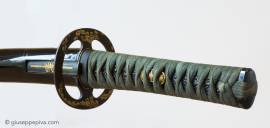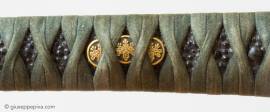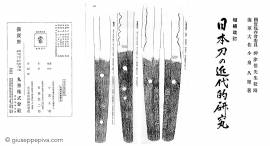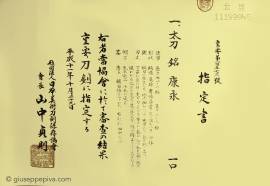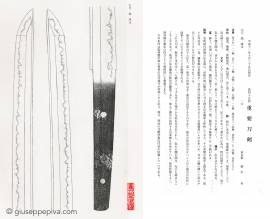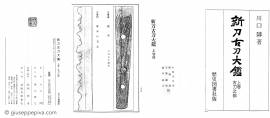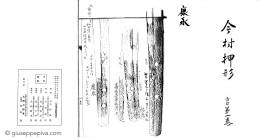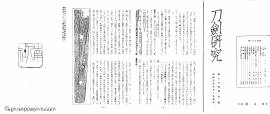Oei-Bizen tachi Yasunaga
Signed "Yasunaga" (康永)
Muromachi period (1392-1573)
Circa 1400
NBTHK Juyo Token (Session nr. 45)
Nagasa [lenght]: 71.1 cm
Motohaba: 2.9 cm, sakihaba: 1.8 cm
Sori: 1.3 cm
Sugata [configuration]: shinogi-zukuri, tori-zori, iori-mune, chu-kissaki (3.4 cm)
Kitae [forging pattern]: itame mixed with mokume, plenty of small jinie and chikei, midare utsuri
Hamon [tempering pattern]: in nioi deki with konie; choji mixed with gunome and togariba with ashi and yō
Boshi [point]: gunome with komaru
Nakago [tang]: suriage, saki asai ha agari kurijiri, katte sagari yasurime; four mekugi-ana (two filled);
Tachi mei [signature]: Yasunaga
Origami: the blade comes with a Juyō tōken (Important sword) certificate issued by the Nihon Bijutsu Token Hozon Kyokai.
Koshirae: The blade comes with a formal uchigatana koshirae with all metal parts decorated en suite with kirimon.
Provenance:
Kishu Tokugawa administrator of Yamaguchi Tanba no Kami Count Ito Miyoji Collection
Literature:
C. Imamura, Imamura Oshigata, 1927, p. 51
Tōken kenkyū, 1930, p. 36
H. Koizumi, Nihontō no kindai-teki Kenkyu, 1969, p. 82 N. Kawaguchi, Shintō Kotō Taikan, 1972, p. 206
Oei-Bizen is a general term for the swords produced by the Osafune smiths during the Oei era (1394-1428). The best sword-smiths from this period are called the “Oei no san-Mitsu”, as their names finish all with the same kanji: Morimitsu, Yasumitsu and Moromitsu.
Yasunaga was son of Yasumitsu and his style can’t be distinguished from his father’s, as he had always been working for him, a common practice called daisaku or daimei, depending on whether the master added his signature himself or not. For this reason swords signed by Yasunaga are extremely rare and this blade has been published in various reference books.
The features of this sword are those one would expect from Yasumitsu: the hada is a mixture of itame and mokume, while the hamon varies from choji to midare, with a prevalence of nioi and a large space between the midare waves. The area of the monouchi is more quiet than the rest, where in some points the hamon shape is sakagakari.
The sword comes from one of the greatest Japanese collections: Count Ito Miyoji, who inscirbed the shirasaya, was a government official and statesman; he was involved in the drafting of the Meiji Constitution and held important posts, including secretary to the Prime Minister, minister, etc.
Inventory Nr: 1759
Info works
Copyright © 2016 - giuseppe piva - VAT: 05104180962




